ENTS:
I recently spent several days with a forestry class of 13
students in the
boreal forest of the Boundary Waters Canoe Area Wilderness, on
Seagull and
Saganaga Lakes, which are on the Canadian border at 48-49
degrees latitude.
It is always a surprise to see spring disappear during the drive
up there
at this time of year. Most trees in Minneapolis have leaves, or
at least
the buds have opened. In Duluth the first few aspen buds are
just beginning
to open, and proceeding north to Grand Marais MN, the deciduous
trees are
totally bare.
Then drive down the Gunflint Trail, which goes
even further
north and adds 1000 feet in elevation along its 55 mile length
which ends
in the middle of the Boundary Waters Wilderness, and you return
to late
winter. The trail at one point passes through an incredibly
battered grove
of 350 year old white pine. They don't look like any white pines
you ENTS
have ever seen, but it is how white pine looks when growing on
shallow
rocky soils in a boreal forest where temperatures go to minus 60
during the
winter, there are frequent droughts, and derechos. We camped at
Trails End
Campground on a rocky peninsula about 200 feet long that juts
into the
Seagull River, with red and jack pines and black spruce that
originated
after a fire in 1801.
| Here are seven pictures from the trip to Seagull and Saganaga Lakes in the
Boundary Waters Canoe Area Wilderness, May 16-18 2005, with students and
faculty from Michigan State University. All pictures were taken by David
MacFarlane, Professor of biometry, Michigan State University.
|
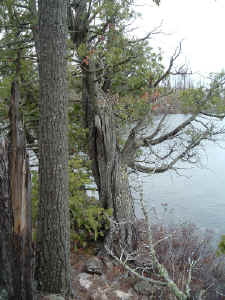 |
Old cedar.jpg. Northern white cedar that survived the 1999 blowdown and
2002 fire. Estimated age about 800 years (tree is hollow).
|
We went out on Seagull Lake to Three Mile Island (at 3 miles in
length it
is the largest of 200 islands in the lake), and were
disappointed to see
that the last red pine from the 1595 cohort has died. It
survived the big
blowdown of 1999, and the prescribed fire of 2002, but was
struck by
lightning last summer. The foliage just recently turned brown.
The good
news is that this tree and several small groves of 200 year old
red pines
around the edge of the island have reseeded the area, and there
is a new
red pine forest popping up throughout the island.
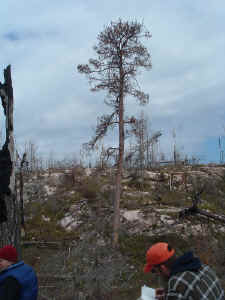 |
Presinosa1595.jpg. 400 year old red pine that died from lightning strike
last summer, on Three Mile Island, Seagull Lake. Stand was blowndown July 4,
1999 and burned Sept 2002.
|
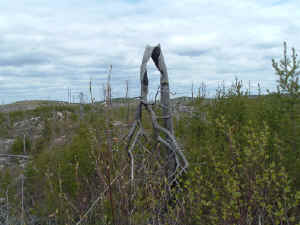 |
Island1995.jpg. Jack pine, white cedar, black spruce and paper birch on an
unnamed island in Saganaga Lake, island was burned in a wildlfire during
May 1995.
|
This is the
first time I
have ever seen large-scale natural red pine regeneration. The
6000 year
heritage of this red pine population has gotten through the
bottleneck and
will persist on this island that now has thousands of
fire-killed snags
that stand black against the 100 foot high pink granite hills
that compose
the island. We made the hike to the opposite side of the island
to see that
the ancient cedars are still there, and their seedlings have
colonized a
100 foot wide swath of recently burned ground around them.
Although we
found red pine seedlings 1000 feet from the nearest seed tree,
cedar seeds
never go more than 100 feet.
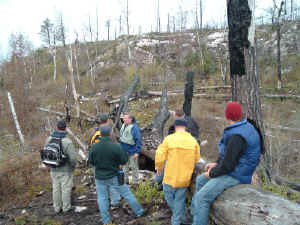 |
Threemille3.jpg. Remnants of 200-400 year old red pine forest on Three
Mile Island, Seagull Lake, blowdown on July 4, 1999 and burned Sept. 2002. |
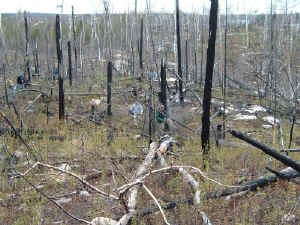 |
Threemile4.jpg. Remnants of 200 year old jack pine, red pine and birch
forest on Three Mile Island, Seagull Lake, blown down July 4, 1999 and
burned Sept. 2002. Note young paper birch and red pine regeneration 2 feet
tall.
|
We also went out onto Saganaga, described by Sigurd Olson as the
ideal
wilderness lake, with its fleets of islands of pink granite,
many of which
are nameless, with different aged forest on each one. We stopped
on Bear
Island to examine its 100 year old even-aged red pine and black
spruce
forest. Then onto some nameless island that had burned in the
Roy Lake
wildfire of 1976, now covered with exceedingly dense jack pine,
black
spruce, aspen and paper birch, their exposed root systems
incredibly
snaking over the granite and just now beginning to be covered
with moss.
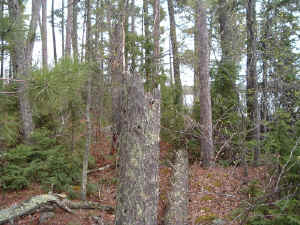 |
Bearisland1.jpg. 100 year old red pine forest with some black spruce
invading the understory on Bear Island, Saganaga Lake. Island was burned in
a wildfire, probably in 1903.
|
Next was Munker Island and its 300 year old, 90 foot tall, red
pine forest
with a 40 foot tall understory of white cedar, foot deep feather
moss, and
many tons of coarse woody debris per acre. Then another nameless
island,
basically a 100 foot high lump of pink granite a few acres in
size that
burned during the wildfire of May 1995. Young jack pine with
open cones
(young trees are open coned and help to reseed the new forest as
early as
age 3, whereas trees over age 12 are totally closed coned), and
miniature
black spruce 1-2 feet tall now cover the island, towering over
the 6 inch
high blueberries.
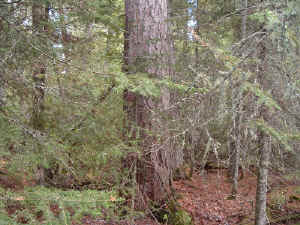 |
Munker1.jpg. 245 year old red pine with fir and cedar invasion underneath
on Munker Island, Saganaga Lake. Island was burned in a wildfire during 1759 |
Then I had a nice leisurely drive back down the north shore of
Lake
Superior, with its white spruce and paper birch forests on 1000
foot high
hills, and many scenic attractions such as the 300 foot bluffs
plunging
into 900 foot deep water at Palisade Head, Split Rock Lighthouse
clinging
to the top of twin 175 foot shards of rock, and the many rivers
swelling
with spring snowmelt, but confined by narrow canyons and pulled
forwards by
numerous waterfalls as they make their way to Lake Superior.
Lots of interesting trees there, but none that will make any
height records.
Lee
|